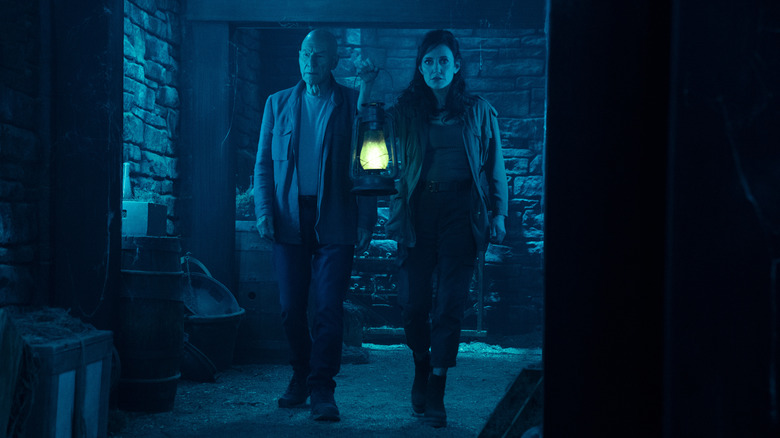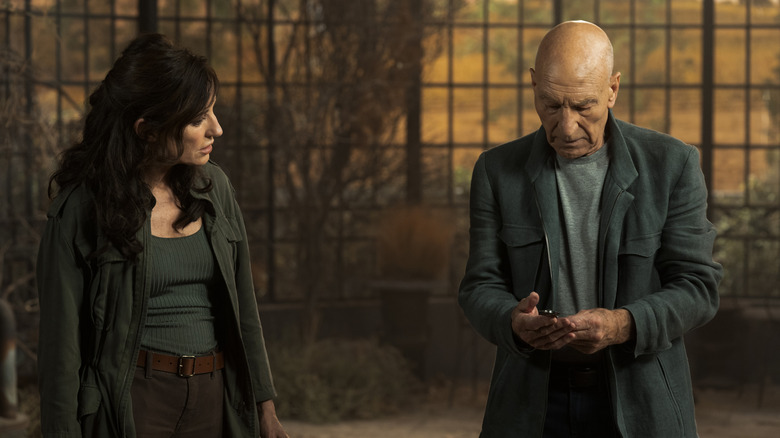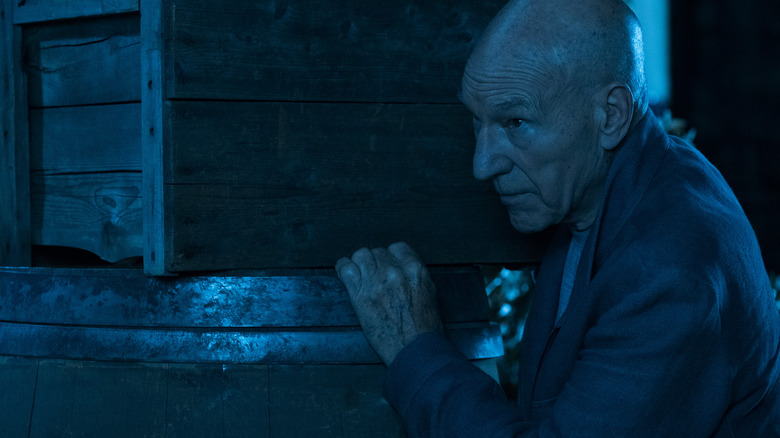Finally, It's Time For Dull, Mind-Numbing Action In Episode 9 Of Star Trek: Picard Season 2
The first season of "Star Trek: Picard," perhaps infamously, was replete with violence and murder. Not an episode passed without one of the show's major characters killing someone. Even the mild-mannered Dr. Jurati (Alison Pill) poisoned an old lover. "Picard" even featured a sword-wielding Romulan samurai in the form of Elnor (Evan Evagora) who could take off people's heads as they would their own hats. Season 2, at least at the start, seemed to be eschewing that clunky, idiotic brutality for something more akin to several classical "Star Trek: The Next Generation" stories. Perhaps it would be about investigating history and causality, and not about vaporizing victims or ripping out eyeballs.
In "Hide and Seek," the penultimate episode of this season of "Star Trek: Picard," audiences are finally treated to the gunfire, violence, and murder they were missing (?). This is the episode wherein Raffi (Michelle Hurd) and Seven (Jeri Ryan) bond romantically over their shared thrusting of a knife into a victim's eye socket. This is the episode wherein the dead Elnor is resurrected in hologram form, specifically for the purpose of murdering infiltrators. This is a "Star Trek" episode that employs the incredibly dull comic book trope that it's okay to commit mass murder if the victims are wearing black, have guns, and are robotic in some way.
"Hide and Seek," carrying over from the previous episode, features a small army of Borg-ified killers led by Adam Soong (Brent Spiner) and Dr. Jurati, now 99% under the influence of the Borg Queen (Annie Wersching). Elnor, Raffi, and Seven lay waste to the infiltrators on board the La Sirena, while Picard (Patrick Stewart) and Tallinn (Orla Brady) evade capture back at the château. Oh yes, and Capt. Rios (Santiago Cabrera) hides out from invaders with his 21st-century paramour Dr. Ramirez (Sol Rodriguez). There are a few twists and turns, but it's the death the showrunners seem most interested in.
Picard's mother
A running motif throughout this season of "Picard" has been the fate of the title character's mother, seen periodically in flashbacks, and the center of the plot in the seventh episode "Monsters." throughout the series, Picard has experienced flashbacks to his childhood wherein he recalled a dark game of Hide and Seek, wherein his mother was locked in a basement room by his father. In "Monsters," it was made explicit that Picard's mother Yvette (Madeline Wise) was bipolar and that his father Maurice (James Callis) had to sternly aid her mental illness. Picard's dark childhood memories are something Trekkies previously did not know about the character, I suppose, but the introduction of all this material has little to do with the plot or the (hardly extant) themes of the season. Picard had mixed feelings about his stern father and would — as learned in this episode — have to reveal that his mother died by suicide, found hanging in the very greenhouse where she and young Jean-Luc used to gaze up at the stars.
This is certainly tragic and dramatic, but — aggravatingly — does not reveal anything new about Picard's character. It did nothing to explain who he was today, his relationships with others, his decisions to become a Starfleet officer, anything of significance. All we know is that he had a traumatic experience as a child. At nearly 100 years of age, it seems Picard might have previously processed his grief, come to terms with it, and might be able to talk about it more frankly. Recall that Picard served aboard a starship wherein he always had a professional psychiatrist sitting to his left, and who would call him into his ready room whenever things seemed difficult for him. "Next Generation" offered mental health services 24/7 for whoever needed them. The trauma story that "Picard" limply tries to communicate seems cheap, given the franchise's former depiction of mental health care.
It's a Borg Queen after all
In the previous episode, Dr. Jurati was seen drinking battery fluid and eating car parts in order to build up the minerals in her bloodstream and allow the Borg Queen, already in control of her mind, to become more Borg-ified. Then, with the newly regained ability to assimilate people, she Borg-ified a small group of mercenaries. In "Hide and Seek," Jurati becomes even more Borg-y, having made her way back to the Borg Queen's corpse, and all the Borg implants therein. She now has snakey computerized veins stretching across her face, and has acquired a set of Dr. Octopus tentacles sprouting from her back. Having imbibed Borg bits back into her body, the Borg baroness bulldozes the barge's brain. Before she can take control, however, Dr. Jurati stops her from within her own mind.
Jurati and the Borg Queen have a subconscious conversation — envisioned as Pill and Wersching having a face-to-face talk — about the true nature of the Borg. Pill's character points out that throughout history, the Borg have always lost and that assimilating people forcibly has left them as villains in the eyes of the galaxy. Pill explains that the true "collective" is not a mechanically shared consciousness, but a diverse group of friends who love each other. Bafflingly, the Borg Queen sees her point and elects to take over the galaxy ... with kindness. Something tells me that the Borg have encountered gentleness, love, togetherness, and family in the past, and merely erased those things.
In the 1996 film "Star Trek: First Contact," Trekkies were first introduced to the conceit that the Borg weren't a machine collective, but a beehive with a queen. A queen who was emotional, lascivious, and sinister. In that film, the Queen (Alice Krige) made for a fun villain but took the cold, unstoppable, machine-like threat away from the Borg. Now they were a species that could be hoodwinked, appealed to, emotionally manipulated. That version of the Borg was continued into "Star Trek: Voyager" (1995 – 2001) wherein they were made less threatening than ever, with Borg stories involving deals and negotiations, and a two-part episode wherein the Voyager crew was deliberately assimilated. knowing they could undo the process later.
In "Picard," the Borg Queen only required a thirty-second pep talk to turn from evil to good. These universe-altering pep talks are common this season.
Status quo
And, in a nod to restoring the status quo, the newly reformed Queen — still in Jurati's body — uses her Borg powers to heal an injured Seven, restoring the exact same Bog facial implants as she had previously.
At the end of season one, Picard was transformed into an android. In this season, Seven is cured of her implants only to have them restored, Elnor is turned into a hologram, and Jurati fuses her brain with a malevolent computer intelligence. The characters in this show are moving further and further away from organic humanity, and closer and closer to artificial life. Meanwhile, the villainous Dr. Soong is seen as wicked for wanting to manipulate genes and "improve" humanity with DNA tinkering. Odd that this is the conflict: Will humanity go down the dark path of genetics, or the light path of androids and machines?
Roddenberry envisioned an optimistic future wherein humanity would unite, war would be a thing of the past, and interpersonal conflict is manageable. I'm not sure if "because we're all machines now" was part of that vision.



